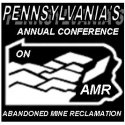In 2015, the EPCAMR Staff continued to focus their attention on providing technical assistance and support to conservation districts and other local governments as well as, community/watershed organizations, economic development organizations, and other partners in the abandoned mine reclamation (AMR) field of interest.
Within that charge, there are several tasks and deliverables that EPCAMR staff meet on an annual basis. Those are to:
- Provide technical assistance to at least one watershed association or non-profit organization in each sponsoring county conservation district of EPCAMR who requests assistance with grants & watershed projects related to abandoned mine drainage (AMD) remediation and abandoned mine land (AML) reclamation. EPCAMR staff provided technical assistance to 31 groups and conservation districts.
See More Those include: WPCAMR, Earth Conservancy, Stream Restoration Inc., Foundation for PA Watersheds, Northeastern PA Alliance, Pennsylvania Environmental Council (NE Office), ARIPPA, Lackawanna County Conservation District, Lackawanna River Conservation Association, Tioga County Conservation District, Columbia County Conservation District, Carbon County Conservation District, Dauphin County Conservation District, Sullivan County Conservation District, Loyalsock Creek Watershed Association, Schuylkill Conservation District, Schuylkill Headwaters Association, Wiconisco Creek Watershed Association, Tri-Valley Watershed Association, Catawissa Creek Restoration Association, Columbia County Conservation District, Friends of the Necopeck, Abrahams Creek Watershed Association, Hicks Creek Watershed Association, Mehoopany Creek Watershed Association, Mahanoy Creek Watershed Association, Shamokin Creek Restoration Alliance, Wildlands Conservancy, Trout Unlimited (National, Western Pocono Chapter, and Stanley Cooper Chapter) and several more groups in attendance at our statewide conference. - Maintain EPCAMR Program Coordination to Conservation Districts in Eastern PA through Monthly Progress Report Documentation and Annual Reports.
See More Please see our Monthly Progress Report Documentation within our EPCAMR Board Page. - Ensure and support the implementation of local watershed restoration and protection plans such as Watershed Restoration Action Strategy (WRAS), Watershed Implementation Plans (WIP), and Qualified Hydrologic Unit Plans (QHUP), including plans to meet Total Maximum Daily Load (TMDL) objectives and to restore AMD impacted watersheds. EPCAMR staff worked specifically in 19 watersheds to plan, assess, develop, and/or implement TMDL objectives & watershed restoration action strategies.
See More Those include: Lackawanna Valley, Wyoming Valley (Newport Creek, Nanticoke Creek, Solomon Creek, Warrior Run, Abrahams Creek, Hicks Creek, and Laurel Run), Schuylkill River, Northern Swatara Creek, Rausch Creek, Catawissa Creek, Babb Creek, Nescopeck Creek, Loyalsock Creek, Babb Creek, Shamokin Creek, Mahanoy Creek, Lehigh River (Hazle Creek). - Plan, Co-Sponsor, and Conduct the Annual PA AMR Conference in partnership with WPCAMR and other planning partners on the conference planning committee and participate in or sponsor regional workshops on AML issues throughout PA. EPCAMR staff co-hosted the PA AMR Conference on June 25-26,2015 at the Ramada Inn and Conference Center in State College, PA.
See More See 2015.treatminewater.com website for more details. Please see our Monthly Progress Report Documentation within our EPCAMR Board Page for other regional workshops. - Provide data, GIS layers, and maps, as a public service to watershed groups and municipalities impacted by AMD/AML.
See More A list of the GIS Data & Map Services is on our EPCAMR website and physically through the EPCAMR GIS Technical Assistance Center (TAC) in the EPCAMR Office. A list of 118 general public and government assisted include the following: PA Department of Environmental Protection (Harrisburg, California DMO, Pottsville DMO, BAMR Wilkes-Barre, BAMR Ebensburg, MRAB), PA Department of Community and Economic Development, PA Game Commission, PA Association of Environmental Educators, PA American Water, Susquehanna River Basin Commission, Office of Surface Mining Reclamation and Enforcement, AmeriCorps, PA Department of Transportation, US Fish and Wildlife Service, US Army Corps of Engineers, US Department of Energy, US Geologic Survey, Aggregate Advisory Board, State Senator Yudichak, Joe Sapienza (videographer), Community Aid Inc., Pioneer Tunnel, Benton Foundry, Susquehanna Mining Solutions LLC, Lackawanna County, Lackawanna Valley Heritage Authority, PA Historic Museum Commission, Plymouth Historical Society, PA Anthracite Section of the Society of Mining Engineers, Penn-State University, University of Colorado, Greater Nanticoke Area School District, Wilke-Barre Area School District, Hazleton Area STEM School, North Schuylkill School District, West Side Career & Tech Center, Wyoming Seminary, Bear Creek Charter School, McGlynn Learning Center, Wilkes-Barre Area School District, Lehigh County Technical Institute, Weatherly Borough Planning Commission, PA American Water, PennFuture (NE Office), Schuylkill River Watershed Congress, Delaware Riverkeeper, Keystone Job Corps, Trinity Artisans, Penn-East Pipeline Company, Nanticoke City, Warrior Run Borough, Ashley Borough, Shickshinny Borough, Plains Township, Laflin Borough, Larksville Borough, Edwardsville Borough, Swoyersville Borough, Courtdale Borough, Forty Fort Borough, Luzerne Borough, Hanover Township, Wilkes-Barre City, Wilkes-Barre Township, PA Anthracite Council, Western PA Conservancy, PA Department of Conservation and Natural Resources, Butler Enterprises, Natural Lands Trust, Eagle Rock Resort, PA Legislature (11 Coal Impacted Districts), Rausch Creek Partners LLC, Skelly & Loy, LandStudies, Luzerne County Community College, Keystone Pure Water Tech Inc., Twin Oaks LLC, University of Oregon, Hedin Environmental, Valley Library, Choose Clean Water Coalition, Bold Gold Media (94.3 FM The Talker, 105 FM The River, and The Game on several AM radio stations), Sullivan Review, Press Enterprise, Citizens’ Voice, Times Leader, Hazleton Standard Speaker, Scranton Times, Greater Pittston Area Historical Society, Kings College, Bucknell University, Bloomsburg University, Susquehanna University, Cornell University, CSI Environmental, State Representative Aaron Kaufer, Wyoming Valley Sanitary Authority, McClane & Associates, Larson Design Group, PA Growing Greener Coalition, Keep PA Beautiful, Chesapeake Bay Foundation and more at our statewide conference. - Provide general EPCAMR Board Administration to increase communication and facilitation with the EPCAMR Board in order to strategically plan and conduct meetings.
See More Please see our Past EPCAMR Quarterly Meetings within our EPCAMR Board Page. - Maintenance of epcamr.org and treatminewater.com and provide information to the WPCAMR’s AMRClearinghouse.org websites.
See More We had 21,310 views by 10,908 visitors in 129 different countries for epcamr.org alone (statistics from wordpress.com). Please see our www.epcamr.org, www.treatminewater.com and WPCAMR’s www.AMRClearinghouse.org websites, respectively. - Suggest to the PA DEP Section 319 Program Stream Segments in the EPCAMR Region that should be reassessed where improvements have been made to streams or segments previously on the 303 (d) List that stand a good chance of being removed from the List with supporting water quality monitoring or biological monitoring evidence.
See More 1.72 miles of Espy Run a tributary to Nanticoke Creek should be removed from the impaired waters list since the upgrade of the Espy Run Treatment System. (1 Segment Reach Code 02050107001053). Influent to the treatment system ranges from 10-20 mg/l of total iron with a 6.5 pH and effluent of the treatment system consistently remains under 5 mg/l total iron with a pH of 7.5 while throughput flow averages about 500 gpm and downstream instream sampling remains under 3 mg/l with a 7.5 pH. The mouth of the stream is misshapen in GIS layer. Iron staining of the streambed no longer exists and aquatic life has returned to the stream. Detailed data over several years can be provided. .
For up-to-date information, we encourage you to visit our website, especially our news page which is in chronological order and searchable. Our current initiatives page is also a great place to see our most recent and future programs.











